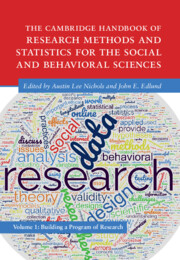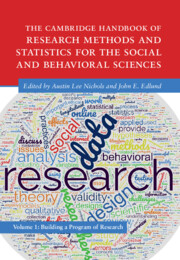The Cambridge Handbook of Research Methods and Statistics for the Social and Behavioral Sciences
The third of three volumes, the four sections of this book cover a variety of issues important to analyzing data to produce high-quality, accurate conclusions from already-collected data. First, leading scholars from around the world provide a step-by-step guide to using several popular quantitative and qualitative statistical programs used throughout the social and behavioral sciences. The next section focused on several important considerations for preparing data for analysis. Many of these directly affect the quality of the data and the resulting conclusions, In the remainder of chapters, the various authors focus on various advanced statistical techniques. In section three, the focus is on those related to quantitative analysis. Section four then focuses on analyzing qualitative data. Throughout the book, examples and real-world research efforts from dozens of different disciplines are discussed. In addition, authors often provide example data and analytical code to facilitate learning of and application of each concept.
- Volume three of a three-volume handbook written for advanced graduate students and current Ph.D. researchers across the social and behavioral sciences
- Features authors from dozens of disciplines and countries to provide a diverse perspective on analyzing data within and between disciplines and cultures
- Serves as a step-by-step guide to performing high-quality research and using the latest advances in statistics to produce valid conclusions and implications
- Covers several advanced statistical techniques and provides advice for effectively using each
- Provides practical applications for analyzing almost any quantitative or qualitative data
Product details
December 2026Paperback
9781009009720
758 pages
254 × 178 mm
Not yet published - no date available
Table of Contents
- Preface
- Part I. Analysis Tools:
- 1. SPSS: statistical package for the social sciences Duncan Cramer
- 2. Reproducible science with R Andy P. Field and Teresa B. Gibson
- 3. User-friendly Bayesian and frequentist statistics with JASP Ruth V. Walker and Julie Madden
- 4. SAS® software for the social and behavioral sciences research Ravindra Khattree and Anuradha Roy
- 5. Mplus: an overview of its unique analysis capabilities Bengt O. Muthén
- 6. STATA Ulrich Kohler
- 7. Unveiling insights: NVivo in qualitative research Popi Sotiriadou and Mohsen Loghmani
- Part II. Analytical Considerations:
- 8. Missing data Gerko Vink and Stef van Buuren
- 9. Detecting insufficient effort responding to questionnaires: techniques and practical recommendations Jason L. Huang and Ran Huang
- 10. Validating statistical assumptions for common statistical techniques Abdel-Salam G. Abdel-Salam
- 11. Data transformations Jason W. Osborne
- 12. Measurement equivalence Jan Cieciuch, Eldad Davidov and Peter Schmidt
- 13. Measures of association: estimates, P-values, and statistical tests Sander Greenland
- Part III. Advanced Quantitative Approaches:
- 14. Non-linear time series analyses Margaret C. Macpherson, Michael J. Richardson and Rachel W. Kallen
- 15. Advanced inferential analyses Vincenzo Guerriero, Roberta Alilla, Giulia Maria Bellucci, Flora De Natale and Barbara Parisse, Marco Tallini
- 16. Mediation and moderation analysis Amanda J. Fairchild, Donna L. Coffman, Dexin Shi, Sarfaraz Serang and David P. MacKinnon
- 17. Moderated mediation and (Not) 'Mediated Moderation' Andrew F. Hayes and The Ton Vuong
- 18. Advanced Bayesian analyses Yasir Atalan and Jeff Gill
- 19. Item response theory and modeling Tenko Raykov
- 20. Advances in confirmatory factor analysis Michael T. Moore
- 21. Multivariate longitudinal data analyses Silvia Bianconcini and Silvia Cagnone
- 22. Partial Least Squares Structural Equation Modeling (PLS-SEM): a rapidly emerging SEM tool Joseph F. Hair, Jr., Misty A. Sabol and Jeffrey J. Risher
- 23. Advanced meta-analytic techniques Mike W.-L. Cheung and Suzanne Jak
- 24. Signal detection theory Michael S. Landy
- 25. Using computer simulations to study social dynamics Francesco Renzini and Flaminio Squazzoni
- Part IV. Advanced Qualitative Approaches:
- 26. Fuzzy-set qualitative comparative analysis Evan John Douglas
- 27. Practicing reflexivity Linda Finlay
- 28. Researcher-as-instrument in qualitative research Michelle Miller-Day
- 29. Transcription in qualitative research Christina Davidson
- 30. Thematic analysis Nikki Hayfield and Gareth Terry
- 31. Discourse analysis Jennifer Andrus
- 32. Narrative analysis Dorien Van De Mieroop and Kim Schoofs
- 33. Transformer models Martin Popel, Jindřich Libovický, Zdeněk Kasner and Ondřej Dušek
- 34. Systematic reviews Katy Sutcliffe, Emma France, Angela Harden and James Thomas.





